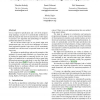Free Online Productivity Tools
i2Speak
i2Symbol
i2OCR
iTex2Img
iWeb2Print
iWeb2Shot
i2Type
iPdf2Split
iPdf2Merge
i2Bopomofo
i2Arabic
i2Style
i2Image
i2PDF
iLatex2Rtf
Sci2ools
OOPSLA
2010
Springer
2010
Springer
A simple inductive synthesis methodology and its applications
Given a high-level specification and a low-level programming language, our goal is to automatically synthesize an efficient program that meets the specification. In this paper, we present a new algorithm and methodology for inductive synthesis that allows us to do this. We use Second Order logic as our generic high level specification logic. For our low-level languages we choose small application-specific logics that can be immediately translated into code that runs in expected linear time in the worst case. We explain our methodology and provide examples of the synthesis of several graph classifiers, e.g, linear-time tests of whether the input graph is connected, acyclic, etc. In another set of applications we automatically derive many finite differencing expressions equivalent to ones that Paige built by hand in his thesis [Pai81]. Finally we describe directions for automatically combining such automatically generated building blocks to synthesize efficient code implementing...
Low-level Programming Language | OOPSLA 2010 | Second Order Logic | Security Privacy | Small Application-specific Logics |
Related Content
| Added | 29 Jan 2011 |
| Updated | 29 Jan 2011 |
| Type | Journal |
| Year | 2010 |
| Where | OOPSLA |
| Authors | Shachar Itzhaky, Sumit Gulwani, Neil Immerman, Mooly Sagiv |
Comments (0)

